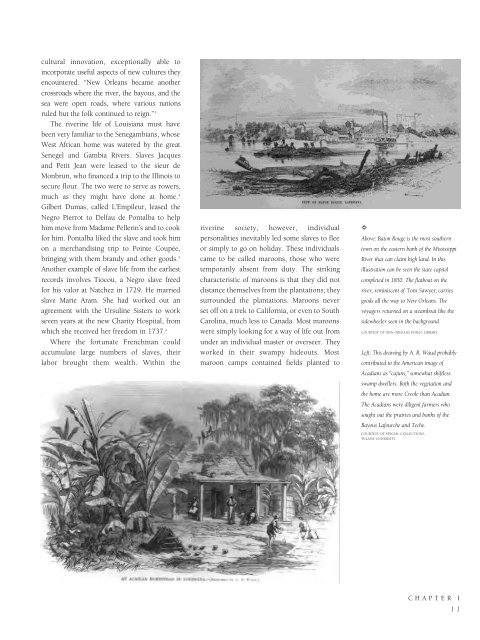Historic Louisiana
An illustrated history of Louisiana, paired with the histories of companies, families and organizations that make the state great.
An illustrated history of Louisiana, paired with the histories of companies, families and organizations that make the state great.
Create successful ePaper yourself
Turn your PDF publications into a flip-book with our unique Google optimized e-Paper software.
cultural innovation, exceptionally able to<br />
incorporate useful aspects of new cultures they<br />
encountered. “New Orleans became another<br />
crossroads where the river, the bayous, and the<br />
sea were open roads, where various nations<br />
ruled but the folk continued to reign.” 3<br />
The riverine life of <strong>Louisiana</strong> must have<br />
been very familiar to the Senegambians, whose<br />
West African home was watered by the great<br />
Senegel and Gambia Rivers. Slaves Jacques<br />
and Petit Jean were leased to the sieur de<br />
Monbrun, who financed a trip to the Illinois to<br />
secure flour. The two were to serve as rowers,<br />
much as they might have done at home. 4<br />
Gilbert Dumas, called L’Empileur, leased the<br />
Negro Pierrot to Delfau de Pontalba to help<br />
him move from Madame Pellerin’s and to cook<br />
for him. Pontalba liked the slave and took him<br />
on a merchandising trip to Pointe Coupée,<br />
bringing with them brandy and other goods. 5<br />
Another example of slave life from the earliest<br />
records involves Tiocou, a Negro slave freed<br />
for his valor at Natchez in 1729. He married<br />
slave Marie Aram. She had worked out an<br />
agreement with the Ursuline Sisters to work<br />
seven years at the new Charity Hospital, from<br />
which she received her freedom in 1737. 6<br />
Where the fortunate Frenchman could<br />
accumulate large numbers of slaves, their<br />
labor brought them wealth. Within the<br />
riverine society, however, individual<br />
personalities inevitably led some slaves to flee<br />
or simply to go on holiday. These individuals<br />
came to be called maroons, those who were<br />
temporarily absent from duty. The striking<br />
characteristic of maroons is that they did not<br />
distance themselves from the plantations; they<br />
surrounded the plantations. Maroons never<br />
set off on a trek to California, or even to South<br />
Carolina, much less to Canada. Most maroons<br />
were simply looking for a way of life out from<br />
under an individual master or overseer. They<br />
worked in their swampy hideouts. Most<br />
maroon camps contained fields planted to<br />
✧<br />
Above: Baton Rouge is the most southern<br />
town on the eastern bank of the Mississippi<br />
River that can claim high land. In this<br />
illustration can be seen the state capitol<br />
completed in 1850. The flatboat on the<br />
river, reminiscent of Tom Sawyer, carries<br />
goods all the way to New Orleans. The<br />
voyagers returned on a steamboat like the<br />
sidewheeler seen in the background.<br />
COURTESY OF NEW ORLEANS PUBLIC LIBRARY.<br />
Left: This drawing by A. R. Waud probably<br />
contributed to the American image of<br />
Acadians as “cajuns,” somewhat shiftless<br />
swamp dwellers. Both the vegetation and<br />
the home are more Creole than Acadian.<br />
The Acadians were diligent farmers who<br />
sought out the prairies and banks of the<br />
Bayous Lafourche and Teche.<br />
COURTESY OF SPECIAL COLLECTIONS,<br />
TULANE UNIVERSITY.<br />
CHAPTER I<br />
11
















